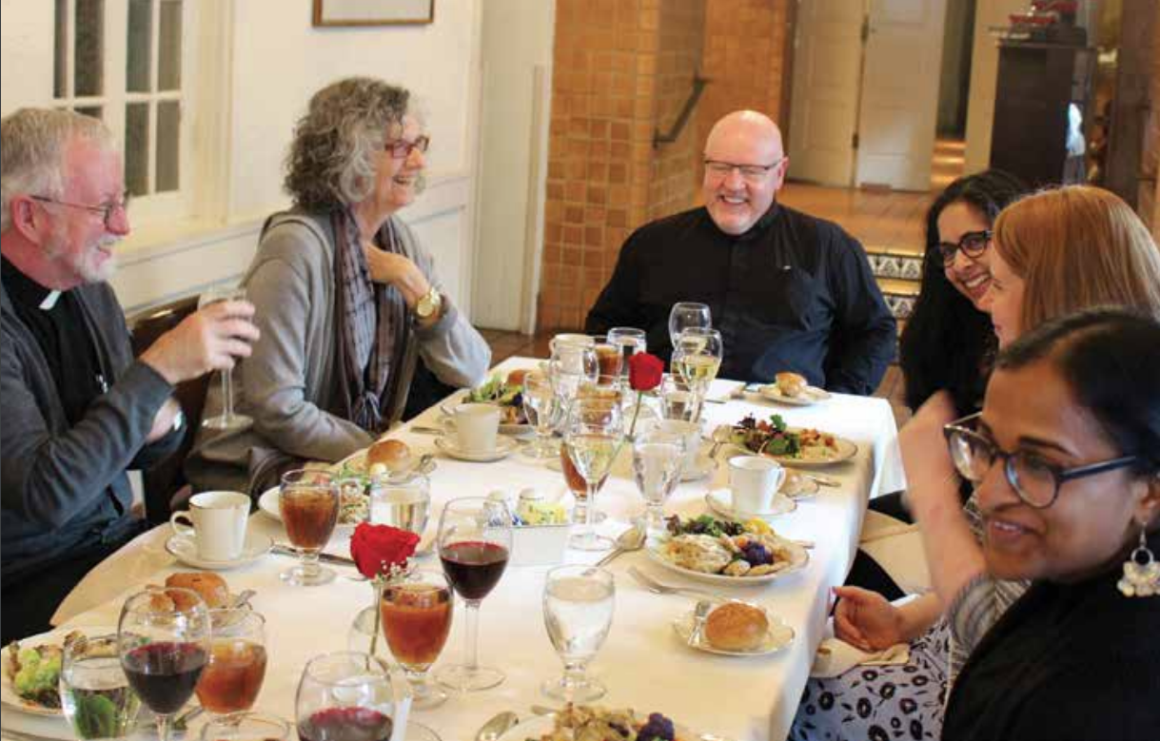
Gender Justice: Transformation Through Interdisciplinary Collaboration
Reflections from the 2016–18 Bannan Institute Faculty Collaborative

By Sharmila Lodhia
Associate Professor, Department of Women’s and Gender Studies
Bannan Faculty Fellow, Ignatian Center for Jesuit Education
Santa Clara University
In fall 2016 the Ignatian Center inaugurated the 2016–18 Bannan Institute, and the country stood on the precipice of a presidential election that would have critical implications for the advancement of gender, racial, economic, and environmental justice. In framing the Collaborative’s focus on Gender Justice and the Common Good, I introduced the theme of the particular visibilities and vulnerabilities that marked that sociopolitical moment and the vital necessity of sustained antiracist, feminist analysis and engagement. I also explored the question of the potential solidarities that might derive from a commitment to gender justice and the common good. An analysis of two cases of sexual violence that had generated massive public outcries served as a point of entry.
I suggested that India’s reaction to the 2012 rape of Jyoti Singh in New Delhi, India, and the U.S. response to the 2015 sentencing of Stanford student Brock Turner for sexual assault, evidenced a greater public awareness and awakening about the prevalence of this violence and the inadequate legal responses to these crimes. Since that time, the U.S. has witnessed subsequent ruptures in the discursive response to gendered violence via the viral explosion of the #MeToo movement and the accompanying hyper-visible discussions of sexual violence and harassment across multiple contexts from the workplace, to public spaces, to carceral institutions. These events prompted demands for legal change, outpourings of support for survivors, and new frameworks for thinking about violence and toxic patterns of gender socialization. While it is clear more work needs to be done, these shifts indicate that activism and sustained engagement by a range of public groups has the potential to transform cultures of violence, and this is significant for those of us who are committed to advancing gender justice.
So in this context, what is to be gained by bringing together scholars from across the University to engage the question of gender justice and the common good, and to what extent does this interdisciplinary dialogue enhance the research we do? Let me answer these questions with a brief foray into the work of our collaborative. Years ago I met Stephanie Wildman, a Santa Clara law professor, at a conference that brought together feminist lawyers, activists, and faculty to discuss strategies for advancing the civil rights of women. Reconnected nearly two decades later, we sought an opportunity to return in a tangible way to some of the issues of gender inequality and discrimination we had explored at that time. A writing project emerged for us in an edited volume called Feminist Judgments: Rewritten Torts Opinions, a project undertaken by law professors and others to rewrite, from a feminist perspective, key legal decisions in the United States, revealing the possibilities for law that a feminist lens provided. This particular volume focuses on revisiting court decisions involving civil wrongdoing while remaining true to tort jurisprudence and social science research available at the time the original decision was rendered. Our task—to revisit the famous Tarasoff v. Regents of the University of California “duty to warn” case, one that is taught to almost all law and medical students and contains a hidden subtext of intimate partner violence. The 1976 California Supreme Court decision involved the death of a young woman at the hands of a graduate student from India who expressed his intention to kill her to a university psychiatrist, who in turn informed campus police and recommended he be committed given the severity of his mental health condition. Campus police failed to detain him, and no one, neither the mental health professionals, nor the police, informed the woman of the threat to her life. Upon her death, her parents filed tort claims against the university psychiatrist and campus police, which are the focus of this case.

Members of the interdisciplinary Gender Justice and the Common Good Bannan Institute Faculty Collaborative share in a meal and conversation following Dr. Cornwall’s lecture on gendered theologies and the common good.
Revisiting the case through the lens of gender justice and the common good has been both challenging and exhilarating. At times it feels like detective work, seeking to uncover legal and nonlegal sources produced prior to 1976 that judges at the time would have access to in rendering their decisions. Stephanie and I worked to incorporate into our revised opinion of the case a meaningful examination of the doctrinal possibilities for expanding the common law’s general unwillingness to find, in all but a limited number of situations, a requirement that an individual has a duty to act to protect another; and in doing so, to offer a more nuanced sense of the gendered and cultural context in which the tragic death occurred.
As part of the gender justice collaborative structure we adopted, we circulated a draft of this legal opinion to the other members of the group for their review and feedback. The conversation that emerged in that meeting crystallizes in many ways the vital and generative framework of interdisciplinary dialogue around shared scholarly and sociopolitical interests. Consider the substance of the 90-minute discussion and what each person in the group brought to bear on our legal analysis of the duty to warn: Patrick LopezAguado offered feedback on our piece framed by a sociological perspective, positing how the shape of urban life, ideologies of capitalism, and the place of individuals in crowded public settings enables us to begin to ignore the needs of others, and in doing so cited the groundbreaking work of Erving Goffman on “civil inattention.” Enter Sonja Mackenzie, a faculty member in public health, who encouraged us to consider engaging the work of radical feminists writing in the period about the political economy of heterosexism and the social contract in undertaking to expand the legal doctrine of duty. Mythri Jegathesan, a cultural anthropologist, offered insights as to the particular sociohistorical moment in which the decision was made and its temporal correspondence with newly enacted gun control and immigration laws, as well as insights into the role of caste in the case, directing us to an early anthropological study of gender and caste in India. Finally, Theresa Ladrigan-Whelpley of the Bannan Institutes encouraged us to wrestle more deeply with the distinction between common goods and public goods in articulating a legal basis for a duty to warn. Suffice it to say we emerged from the meeting equipped with rich scholarly and theoretical insights to pursue as we finalize our work on this forthcoming publication. The group’s collective expression of the value of this feminist legal judgments project to expanding thinking and engagement with issues of gender justice inspired us and informs the ongoing work.
The value of sustained, institutionally structured, and financially supported interdisciplinary research clusters such as this in advancing Santa Clara University’s teacherscholar model cannot be overstated. Though we are colleagues at a relatively small institution, we often remain siloed off from one other’s scholarly pursuits, even when our research interests intersect. I am especially grateful that the particular structure of this incarnation of the Bannan Institutes also enabled us to engage issues related to the shifting political climate and what it means to be teaching topics related to gender justice—locally, nationally, and transnationally— at this crucial moment. We have borne witness to increasing evidence of racialized and gendered violence in multiple sites, and the rise of hate groups, white nationalism, and other extremist movements. Recent incidents within our own campus involving racism, transphobia, misogyny, and anti-immigrant sentiment present a reminder that our work in advancing the common good in relation to racial, gender, environmental, and economic justice remains unfinished—not just out there but right here, on our campus. It is incumbent upon us as faculty and as a university to develop forms of leadership that will serve this particular moment in history. Together, how can we truly actualize, rather than merely rhetorically invoke, a commitment to social justice and the common good?
SHARMILA LODHIA is associate professor in the Department of Women’s and Gender Studies at Santa Clara University. She earned her J.D. from Hastings College of Law in San Francisco and her Ph.D. in women’s studies from UCLA. Her research examines legal responses to violence against Indian women through a transnational lens, highlighting the impact of migrating spouses, traveling cultures, and shifting bodies of law in the diaspora. Her work has been published in Feminist Studies, Women’s Studies International Forum, Violence Against Women and the Columbia Journal of Gender and Law. She was a co-editor of New Directions in Feminism and Human Rights, published by Routledge in 2011. Her current research examines the contradictions and complexities of global advocacy for women and specifically why certain dominant frameworks of intervention can hinder rather than advance women’s rights.
| Gendered Theologies and the Common Good | Home | Not a Roadmap but a Trail: Environmental Reconciliation with the Commons |